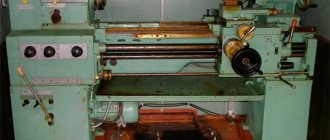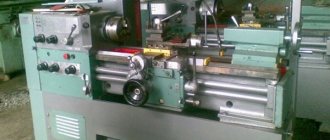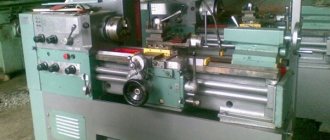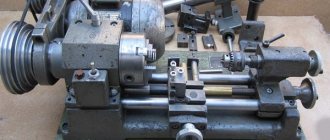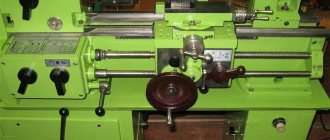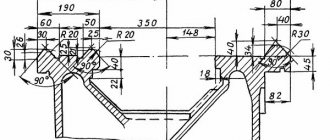The rooms equipped for labor training classes in the country's secondary schools, vocational and technical schools and colleges are equipped with a metal-cutting lathe - TV-7.
Its direct purpose is to provide qualified training to future personnel of manufacturing enterprises in the working profession - turner.
Specifications
The new device was obtained as a result of the modernization of the TV-6 machine. It differs from the previous one in the presence of a gearbox, a shaft that serves to transmit force from the electric motor to the workpiece. The device allows you to check the alignment of the part with its axis of rotation.
Description of the main distinguishing features:
- classification according to the accuracy of thread manufacturing - “N”;
- weight – 40 kg;
- dimensions – 105x53.5 cm and 105x120 cm;
- distance from the frame to the central part – 120 mm;
- the length of the blank fixed in the central part is 330 mm, the same in the cartridge - 310 mm;
- blank grooving distance – 300 mm;
- length of movement of the cutter slide – 85 mm;
- the chord of clearance of the main shaft passing through the inside of the part is 18 mm;
- the period of rotation of the part around the axis is 8;
- the degree of repetition of torsion of the main shaft head is 60-1000 rpm;
- the diameter of the blank, which is fixed above the device body – 220 mm, the tool holder – 100 mm;
- height of the device holding the cutter – 16x16 mm;
- tool holder movement distance – 260 mm;
- longitudinal and transverse adjustment of the tool holder according to the limb layout - 0.025 mm;
- the value of the tool holder approach period is 8;
- The rotation angle of the slide where the cutter is installed is +/- 45.
The equipment is equipped with elements that protect against damage from chips - a shield, a transparent screen.
The first is installed above the chuck, and the second is on the caliper. It is lowered over the area in which the part is being processed.
Types of work performed on the machine
On the TV-7, 7m machine the following is produced:
- cutting alternating protrusions and depressions on the surface of parts located along a helical line;
- complete separation of a certain part of the workpiece along an open contour;
- expansion of gaps in large and small metal objects with preliminary shapes in accordance with given dimensions;
- grinding surfaces to give the shape of a cone or cylinder;
- drilling through or blind cylindrical holes;
- trimming the end parts of future parts.
Electrical equipment
The electric motor and reduction gearbox are mounted in a cabinet located on the left side. Their shafts are equipped with 4 pulleys, which have different diameters. They are arranged in ascending order from smallest to largest - at the engine, and vice versa at the box body.
Electrical equipment consists of:
- asynchronous motor with a power of 1.1 kW, which is mounted in the left pipe;
- shield installed in the cabinet on the right side. Mounted on it are a switch, a starter, a fuse and an emergency switch;
- a cam switch located at the rear of the frame;
- power buttons and lighting devices installed on the side.
Analogs
An analogue of the TV-7 machine is its improved model - TV-7m, manufactured by the above-mentioned plant in a desktop version.
Features:
- main dimensions of the model – 1120x640 mm, 1120x680 mm;
- electric motor performance – 750 W;
- the maximum distance for moving the headstock quill located at the rear is 65 mm;
- The diameter of the manufactured parts when they are fixed above the device body is 220 mm. The same above the caliper – 100 mm;
- length of the processed element installed in the central part – 275 mm;
- processing length of the part installed in the chuck – 250 mm;
- the height of the device serving as a holder for the cutter is 16x16 mm;
- maximum weight of parts to be processed – 5 kg;
- spindle head clearance diameter – 18 mm;
- the number of stages of rotation of the workpiece around the axis of the main shaft is 6.
In order to simplify the design, the TV-7m machine is equipped with several pairs of gears with different gear ratios. They, together with the shafts, convert the torque to a given parameter.
The following operations are performed on it:
- boring and grooving of surfaces of various shapes;
- cutting, drilling, trimming parts;
- trimming, cutting external and internal threads;
- grinding of manufactured parts.
Notes on the TV-7 seven
Due to the recent malfunction of the handheld storage medium, a lot of interesting things were lost. And while reviving the seven, I decided to save everything on this topic on the cloud, that is, here. Over the years, my memory is no longer the same, and I might listen to some useful things. )))
Several years ago I purchased such a constructor
The machine has been battered by life, moths have eaten teeth in the gearbox, the shaft screw is bent, the rack is a little chewed. At the camp, from pioneers to pensioners, the whole detachment straightened the nails. There is oil in the headstock, the gears are like new, the cone is intact, the spindle is almost scratch free. There's even a mother nut in the apron!
I ran a file over the frame where the humps were, and it definitely didn’t make it any worse. I washed something, wiped something. A caliper was purchased, a tailstock was purchased, and one gear was turned into an apron. I installed the existing screw from the four and even tried to make a gear shaft that still works to this day. I straightened the teeth of the slats, sometimes with a file, sometimes with a milling cutter. I got carried away with the cartridge, the 160th turned out to be too big. The Chinese sent a frequency generator. The engine is from some kind of pump, 750 W. So the shavings were released using 8x8 nail files.

Initially I wanted to push, but something always gets in the way, either there is not enough time, or the green toad is choking me to spend something, or just plain laziness. The gears were removed from the headstock. I installed sealed bearings on the spindle. A couple of years passed like this. Only the engine changed to 1.5 kW, 1500 rpm, and the 130th cartridge.
The other day I decided to restore what was missing, in the classic version, cutting threads, automatic feed. I tried on the service box from the four, it doesn’t fit. Case openings, top bottom, 5 mm difference. And you can't drill new ones. I decided to transfer the insides. You will also need to cut a new cover.
When I changed the bearings, I also removed the gear from the spindle, it was time to collect the stones, and returned it to its place. I also installed sealed small bearings. Whether this is good or bad, I don’t know. Let it be for now.
I installed paranite gaskets. Filled up with oil. Adjusted the PB according to the rolling pin.
I decided to glue linings to the carriage. I was pleased with the result. But there is a minus, you need to lower the apron, the clamps, the 16 cutter will no longer fit. I didn’t scrape it, so I scrunched it a little for a better fit on the paint.
I straightened the screw a little. The shaft is original for discarding, I will saw through the quad, it fits into the spindle.
The flange was sealed with sealant. I haven't bored out the jaws yet.
I sharpened some aluminum. Rod 20 mm, length after jaws 150, without center. It was easy to remove a couple of millimeters per radius. Then he took off a ten, not to say that it was a mirror, but better than it was. A cone with a length of 100 mm was 5 acres per diameter. There is no automatic feed yet.
I blew the dust off the thread cutter and played with it a little. I'm waiting for additional gears in the apron.
There was a grinding noise from the gears when cutting threads. Based on the marks, I identified the culprit: a 77-teeth gear, a worn bushing. I'll cut a new bushing.
For today it’s something like that. )
Machine care
TV-7, TV-7m machines must be regularly inspected before performing functional duties, and metal shavings must be removed from the parts that determine the direction of movement, installed on the body and support. They are lubricated with oil upon completion of work. The accuracy of manufactured parts and the period of operation of the machines are determined by their care.
All movably connected parts and devices are subject to timely lubrication. The procedure is carried out by a gear immersed in oil, which transfers drops to other elements. The gearbox and feeds are subjected to this procedure.
It is monitored through a peephole located on the headstock. Oil drains from the rear.
Features of installation of the TV-7M machine and its first launch
Installation of the TV-7M educational turning and screw-cutting unit should be carried out on a table or a manufactured stand with a height of no less than 660 mm and no higher than 680 mm from the floor level. The height must be maintained in accordance with the relevant ergonomic requirements.
The cabinet can be made of wood, but to ensure sufficient rigidity of the base, metal corners and sheet metal are best suited. Before fixing the screw-cutting machine, it must be leveled in two planes.
Before using this machine for the first time, you must complete the following mandatory steps:
- carefully read the operating manual of the machine, study its design and safety rules during operation;
- clean non-paintable surfaces of the unit with napkins or rags soaked in solvent to remove the anti-corrosion coating;
- check the presence of grounding; if it is missing, then it must be done in accordance with the rules;
- fill the lubrication and oil filling points;
- check the position of all handles of the lathe control system (they must be in the neutral position);
- connect the power cable to the terminals of the terminal block.
At the initial stage, within 30–40 hours of operation of screw-cutting turning equipment, it is not recommended to perform turning operations at maximum spindle speed.
Safety precautions
Basic operating rules:
- issuing permission to work only if you have special clothing;
- installation of equipment on a rigid foundation;
- grounding device in accordance with the requirements;
- checking the serviceability of moving parts, cutters, and the presence of protective guards;
- using a wooden lattice as a stand;
- properly securing the part to be processed;
- use of cutters with proper sharpening;
- checking the fixation of the tailstock after installing the part in the central part;
- timely removal of metal shavings.
Equipment management
Since TV-7 was created for use as school or educational equipment, managing its operation does not present any great difficulties. Even from the photo of the device it is clear that it is not difficult to master the operation of such a unit.
TV-7 controls (click to enlarge)
The design of the turning TV-7 has several package-type switches; a button responsible for emergency stop of the work process; a button that starts the rack and pinion gear; flywheel to control the longitudinal movement of the carriage; a second flywheel, with which the tailstock is moved; as well as a number of management bodies responsible for carrying out such operations as:
- turning on the reverse mode of operation of the main engine;
- tension of the belt connecting the electric motor to the gearbox;
- starting the feed of the machine support in the longitudinal direction;
- fixing the tailstock on the bed guides;
- moving the slide in the transverse direction;
- change in feed direction;
- activation of the lead screw and the lead roller;
- changing the rotation speed of the spindle assembly;
- selecting the feed rate and pitch of the thread being cut.
The main purpose of TV-7 is to train young specialists
A review of the design of the unit will be incomplete without mentioning the three handles responsible for:
- turning on the lead screw nut;
- quill fastening;
- fixing the cutting head in the required position.
All of these controls allow you to effectively perform simple turning operations on metal workpieces.
Even from a brief overview of the TV-7 model lathe, it is clear that with the help of this device you can quickly master the basics of turning and the principles of managing metalworking technological operations.
